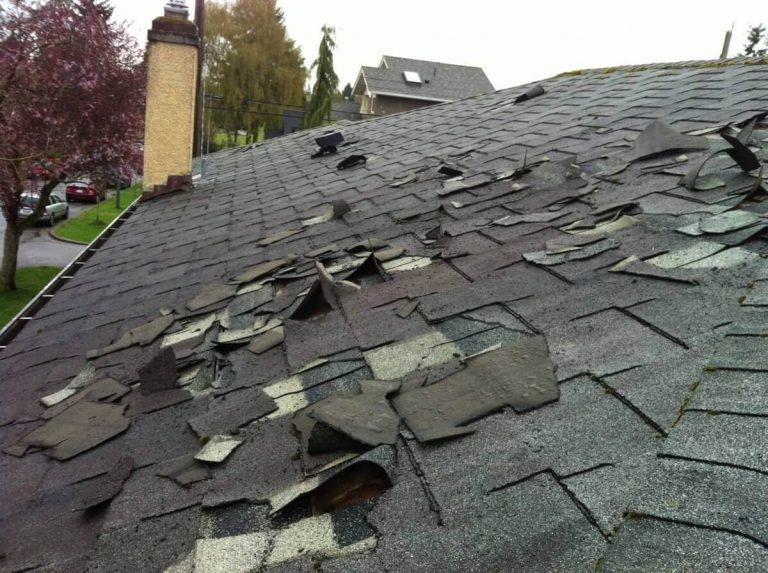Imagine spending thousands on a new roof only to receive one that’s even more susceptible to damage and leaks than the old one. This is the fuel of nightmares, a nightmare some of us have been unfortunate enough to experience. The only real way to awaken from this undesirable reality is to catch the mistakes early. This allows for smaller patch repairs from your roofing company on their dime, rather than repurchasing a whole new roof years earlier than expected. In either case, here are some signs of a bad roofing job you need to look out for after installing a new roof.
Sinking And Sagging
Roofs should run straight, a precision created by quality decking and careful framing. If either of these aspects can’t be found within a roof, you’ll be able to notice even peering up from your front lawn.
The decking running beneath the shingles is something contractors may scrimp on, leaving gaps beneath the plywood that allows the shingles to sag and leak water. If the framing isn’t done well, everything built on it will likewise suffer in both wonky appearances and structural integrity.
A good roofing company will install decking uniformly, without gaps, and they will ensure that the framing base is flawless enough to support the rest of the roof.
Missing, Damaged, or Different Shingles
A clear sign of a cost-cutting contractor will show up in the shingles themselves, either in bald patches, warped and damaged shingles, or even shingles of different material and color-meaning the roofers ran out of the shingles you agreed on and remedied the situation with whatever they had on hand.
If your shingles are strangely damaged, even before any rough weather, this could indicate reused shingles or even a patchy replacement job. A reputable contractor will undoubtedly order enough shingles in your preferred style and use only these new ones–even if some of the old shingles seem ‘fine’.
Free-Range Nailing Technique
To function properly, shingles need to be installed properly. One of the easiest ways to botch this up is by nailing in a haphazard pattern, with little uniformity in the space between nails or where they plunge through the shingles. Under-nailed shingles will have a much higher chance of lifting and blowing away in high winds, letting in moisture and causing undue damage.
A proper installation will consist of a detectable nailing pattern, one that is uniform and positioned within the shingle to make the fit as snug as possible like the fit of custom frames in your home. The nails themselves must also follow certain regulations, as a rusting nail will let in gallons of rainwater over time.
Reusing Structural Material
As with shingle reusing, some roofers will also reuse other materials to keep things cheap. The metal flashing running over seams and peaks is commonly reused in bad roofing jobs, often because it looks to be in good enough condition to use again.
A good roofer will know that the nail holes in these panels are the real issue, and because they cannot guarantee a water-tight fit between old flashing and new nails, the old flashing must be replaced.
Trailing Stains
Dark lines running down the slopes of your roof are generally a bad sign, indicating water damage. The occasional leak can usually be repaired without undergoing a full roof replacement, but if the water damage has reached the decking it may be time to install a new roof and start fresh.
If you see staining in your attic, the leak is likely a severe one. Poor installation of shingles, decking, flashing, and underlayment can all encourage water leaks, which is why it is vitally important to invest in a good roofing company.
Missing Drip Edge or Underlayment
The drip edge runs along the bottom of a roof, directing water to the gutters and away from your home’s foundation. They also ensure water movement, and without a drip edge you’ll notice mold, rot, and staining on your roof and within your home, potentially even a flooded basement.
Good contractors know this and will be sure to install this crucial piece of roofing hardware. The waterproofing underlayment layer, nestled just beneath the shingles, keeps everything below it dry–from the decking to the contents of your home.
Without this, leaks will run rampant and age your roof over twice as fast, which is why no qualified roofer would or should forgo this part of roof installation.
The key takeaway
It pays to do your research whenever you’re investing in a home renovation project. Roofing is no different and because of the cost of a new roof, it’s important to be able to spot the signs of a bad roofing job so you don’t end up paying through the nose.
Most quality companies offer workmanship warranties but if you’re not sure what good workmanship is, you might let some crucial mistakes go on unnoticed which will cost you a bundle later on down the line.
Do your homework and get familiar with the product you’re buying and the contractors you’re buying from. Hire a quality contractor based on their referrals, reviews, and history of the company. Remember that even the best can make mistakes, so be prepared to call out your roofer at the first signs of a bad roofing job as soon as possible.

